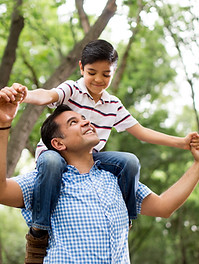Mindfulness for Young People

If you are a young person taking a look at this website, you may have read the What is Mindfulness? page. Maybe you have heard about mindfulness from the media or your family or friends. Perhaps you are thinking along the lines of: "Okay, so mindfulness is about taking control of your thoughts...and I can see that could be useful...but how do you do that exactly?"
Some people find the idea of thought control weird or scary. It sounds a bit sci-fi when you put it like that, but please be reassured that there is nothing to worry about. Mindfulness practice is just about being real and connecting to whatever is happening for you in the present moment. It is not about making or forcing yourself to do anything.
How do you do that, then? Well, if you think about what your brain is doing all the time, it divides into conscious and unconscious functions. Let's put aside all those jobs the brain does without any effort on your part such as keeping your heart beating and sending impulse messages between parts of the body. How incredible it is that all those amazingly complex chemical and biological events take place every second of our lives!
The conscious activities we all undertake can be roughly divided into thinking and sensing. Looking at the illustration here, the level indicated by dotted line A shows mental activity largely made up of thinking while a tiny amount is spent sensing. This is where most of us spend the majority of our time, in mental terms.

At point A, we are mostly thinking/daydreaming/worrying/planning while a small bit of our mind is aware of hunger or warmth or tiredness. The sensing part may even notice, to a small degree, sounds, smells or taste. But, mostly, thoughts are whizzing round our head and, as we all know, thinking is not always clear and purposeful. Thinking is not always enjoyable and it is not always what we want to be doing. Especially if we are trying to sleep, concentrate, revise for an exam or perform at sport or drama. At these times we need to be able to focus and not be swept off by wild and errant thoughts. If we're trying to sleep, we need to be able to let go of our thoughts and allow our mind and body to rest.
Our mind can go round and round in circles, playing back what someone said to us or wrote about us on social media. We can find anxious or negative thoughts stick in our mind, much more so than positive ones. The numbers of young people experiencing stress, anxiety and depression are growing all the time. It is being considered by some mental health charities as an epidemic. I know many young people who find their teenage years unbearable at times because of difficult, painful thoughts they seem to have no control over.
Look now where dotted line B is in the illustration above. The blue thought area is now a fraction of what it was at A. The mind at point B is taken up almost entirely by what it can feel, touch, taste, see and smell. The mind at this point is not worrying or planning. And this is the key practical method to shift the activity of the mind. By practising mindfulness, by coming fully into the the body and what it is sensing in the present moment, we can alter what goes on in our minds.
The most established way to shift your mind from thinking to sensing it to try and become aware of the sensation and movement of the breath in the body. The breath anchors us to the present moment and it is always there, always in motion. A mindfulness teacher once suggested to me to "find the breath fascinating" and this is great advice. Give it a try. Like most things, the more you do it, the easier it gets.
Looking back at the diagram of our rectangle - usually neither point A nor B is where we spend all our time; we fluctuate constantly up and down the rectangle. But by introducing a mindful practice we can take more control of what is going on for us. With this control come some serious possibilities: better sleep; less anxiety and stress; better relationships; better performance in exams, sports or music; more enjoyment of simple pleasures; and feelings of peace and relaxation.
Sound good? Check out the recommendations below!

If you are a young person interested in mindfulness:
-
Use the Resources page to find apps, books and web support
-
Consider some of the suggestions on the Things to Try page
-
Talk to a teacher about the Mindfulness in Schools Project and bringing .b or Paws b to your school
-
Try it for yourself! See what can happen.
If a young person in your life could benefit from mindfulness:
-
Use the Resources page for apps and books to help
-
Look at the Things to Try page
-
Talk to your child's school about introducing mindfulness courses
-
Persist with helping children learn practical tools to help with anxiety and sleep difficulties


